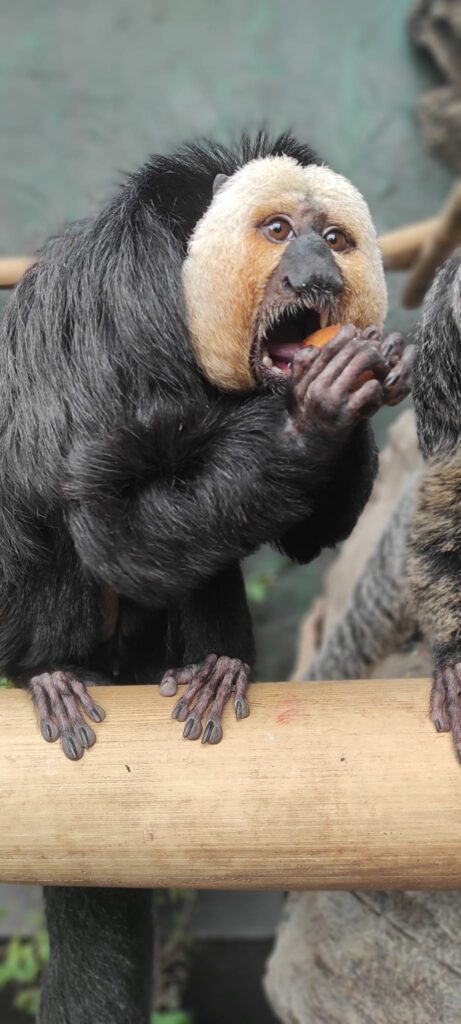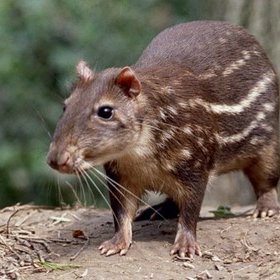The results of this study demonstrate that white-faced sakis display marked food preferences in a two-alternative choice testing situation for a selection of food items that are part of their captive diet. These food preferences significantly correlated with energy content but not with the contents of the individual energy-rich macronutrients carbohydrates, proteins, and lipids.
Macronutrients

The sakis’ food preferences were found to correlate significantly with energy content, suggesting that white-faced sakis are opportunistic feeders with regard to energy gain. This means that the sakis, unlike some other primate species, do not base their food preference on a particular source of metabolic energy, such as carbohydrates, but instead they prefer foods that are high in any kind of energy source which may include carbohydrates, proteins, or lipids.
The low correlation values (rs) and the lack of statistical significance of the correlations between the sakis’ food preferences and carbohydrate and total sugar content, respectively, suggests that the sakis do not explicitly prefer foods with high values of soluble carbohydrates to meet their metabolic energy requirements. These results are consistent with Norconk and Conklin-Brittain’s report (in 2004) on white-faced sakis in the wild having a lower intake of free simple sugars than other frugivorous primates.

Although the correlation between lipid content and food preference was only statistically significant for Lisha (Spearman rₛ = 0.55, P ˂ 0.05), it is remarkable that the group’s preference ranking correlation value with the lipids was higher than the ones obtained with the carbohydrates and proteins. This result is also consistent with the same Norconk and Conklin-Brittain study, where Venezuelan white-faced sakis in the wild were reported to exploit seeds for their high lipid content in order to achieve an extraordinarily high average lipid intake.
The wide interannual variation in crude protein intake by white-faced sakis is attributed to insect availability, represented in the present study by mealworms. Although mealworms were the food item with the second highest protein content, they were only placed 7th in the group’s preference ranking.

The significant negative correlation found between water content and the sakis’ food preference ranking reflects a low preference for food items containing high proportions of water. This finding is in line with the fact that white-faced sakis are accustomed to having free access to water resources such as natural tree cisterns. Without having to rely on water-rich food items to meet their water requirements, the sakis can therefore prioritize food items with higher energy values, which are typically low in water content.
The exploitation of lipids over carbohydrates and proteins is reasonable from an energetic point of view; lipids provide 9 kcal/gram whereas both carbohydrates and proteins provide only 4 kcal/gram . However, the fact that most frugivorous primate species studied so far rely mainly on carbohydrates as their primary source of metabolic energy, suggests that the effective exploitation of lipids may require evolutionary adaptations of the digestive system that are only favored under certain selective pressures and which may have acted upon the white-faced sakis.
Comparison with other species
A significant positive correlation that explains the increasing preference for food items with higher energy values was also found in squirrel monkeys, spider monkeys and pacas. Based on these findings, all of these species were considered to be opportunistic feeders with regard to energy gain. The preference for food items with low water content found in these species and was also thought to be due to the fact that plant food high in water content is usually low in energy values.



On the other hand, white-handed gibbons, pigtail macaques and ring-tailed lemurs, did not show a significant preference towards foods that are high in energy value, but instead towards a specific source of metabolic energy, in this case carbohydrates.



The fact that some primate species seem to be opportunistic feeders with regard to their preferred source of metabolic energy whereas others are not, has been speculated to be due to variations in the degree of frugivory of said species. Another proposed explanation for the fact that some primates have a preferred source of metabolic energy while others do not, derives from the avoidance of competition between sympatric species that developed different preferences for different sources of metabolic energy.
Conclusion
According to the results of the present study, when provided with 15 different food options, zoo-housed white-faced sakis demonstrate marked food preferences in relation to nutrient composition. The sakis’ food preference was significantly positively correlated with the total energy content and negatively with water content. No specific source of metabolic energy was found to be significantly correlated with food preference, although lipids had the strongest correlation with food preference. This is an unusual finding in frugivores, but also one that supports the idea that white-faced sakis exploit seeds for their nutritional value and their high contents of lipids in particular.